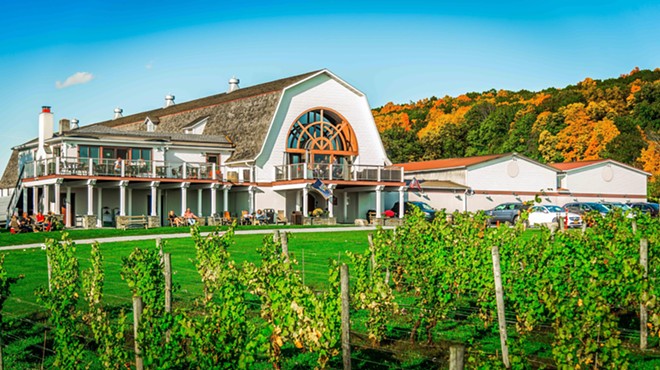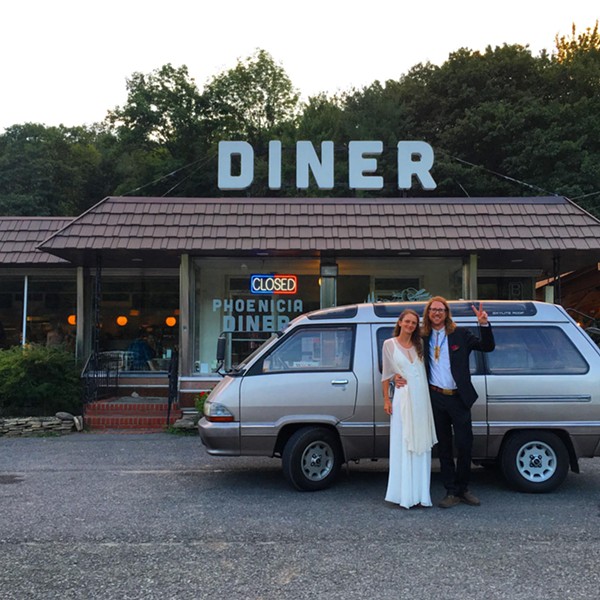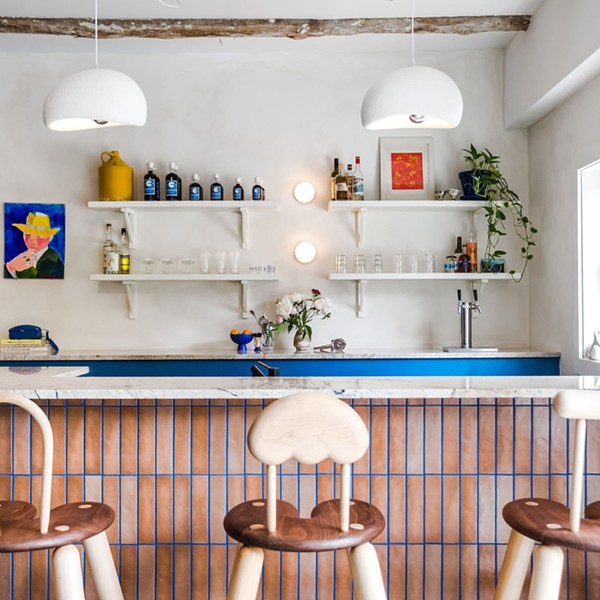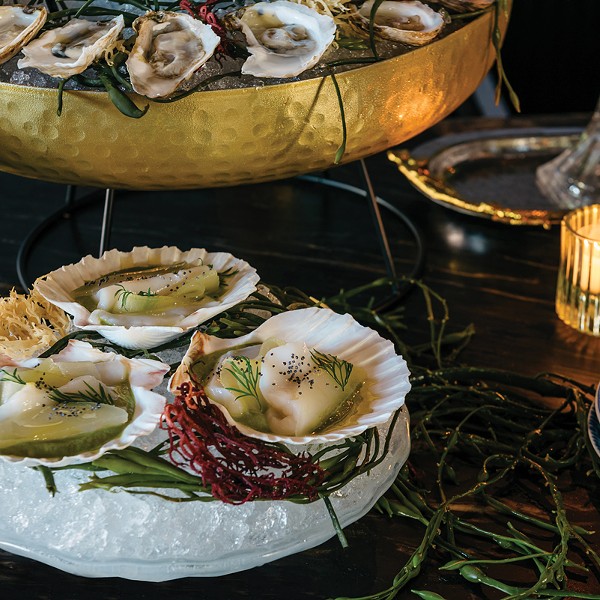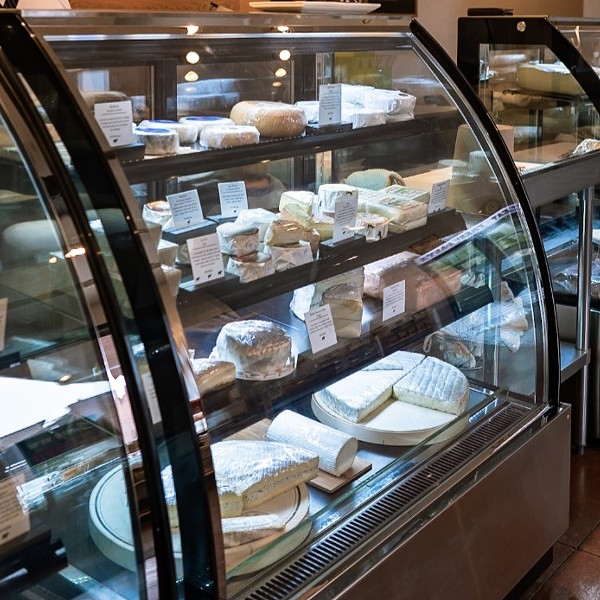It is no small achievement that the Calico Restaurant and Patisserie, a seven-table dining establishment in Rhinebeck, is celebrating a decade of successful operation. This past year, four of New York City's legendary French restaurants - La Côte Basque, Lespinasse, Lutèce, and La Caravelle - closed, and here in the Hudson Valley, Cripple Creek, one of Rhinebeck's finest restaurants, also shut its doors. The closings are a reminder of the difficulties restaurants face in today's competitive environment. "Closures" do not necessarily mean the inability to make money, but for the restaurant owner it must be anxiety-provoking to know that six out of ten restaurants close within their first three years and that of the half million restaurants in the US approximately 10 to 15 percent fail each year.
Calico owes its success to the skill, vision, and hard work of its two owners and chefs, Anthony and Leslie Balassone, a husband and wife team, who both grew up in Poughkeepsie and went to Arlington High School. Their culinary backgrounds reflect two different approaches to becoming an accomplished chef. Anthony was formally trained and distinguished himself as a student at the Culinary Institute of America. After graduating in 1981, he gained further cooking experience by working at Le Pavillon in Poughkeepsie under chef-owner Claude Guermont and management experience working at the IBM and Westchester Country Clubs and at restaurants in Indiana.
Leslie's training as a pastry chef was modeled on the apprenticeship system. She developed an interest in pastry-making while working in a local bakery. During college, she worked in a French patisserie in Boston and after graduation acquired advanced French pastry-making skills from a master French pastry chef in Marblehead, Massachusetts. Having made the decision to become a pastry chef, Leslie moved to Armonk, New York, where she expanded her repertoire to include Austrian approaches to baking.
Anthony and Leslie's friendship blossomed during these years, and they came to share not only a love for each other but a dream of co-owning a restaurant where they could each focus on personal specialties. They envisioned combining a restaurant with a patisserie. In 1994, they married and also rented restaurant space in Rhinebeck that had two kitchens, one where Anthony could design the menu and exclusively do the cooking and another where Leslie could focus on creating and preparing her pastries, cakes, and other desserts.
Restaurant size often correlates with profitability: a large restaurant means that people generally do not have to wait for tables when the restaurant is busy, that those who wish to celebrate a special occasion with a large party can be easily accommodated, that an enlarged bar area can rake in substantial revenue, and that the entertainment factor of eating alongside a crowd of others may be enhanced by the noise, energy, and excitement they produce. Larger restaurants, while they have higher overhead and food supply bills, also have more buying power with suppliers. But bigger is not always better. Anthony and Leslie were not concerned about the small size of their restaurant because they believed it would allow for a high degree of quality control, low labor costs, and minimal food waste.
While they both work 75 to 90 hours a week and rarely take vacations, they insist that they love what they do. Leslie begins her day preparing pastry around 6AM and works the front of the house during dinner. Anthony starts his day around the same time as Leslie, doing prep work and preparing sauces. Their hard work has paid off: over the years they have built up a loyal clientele and received significant awards, including being invited five times to prepare dinner at the prestigious James Beard House in New York City.
The restaurant itself, sequestered in a plate-glass storefront located across the street from the historic Beekman Arms Hotel, is modest and restrained in appearance. The antique green walls complement the light oak floor and cream-colored ceiling, below which various decorative objects are displayed on shelves running along the upper walls of the room. The majestic pastry display case towards the back of the dining room catches your eye immediately upon entering and tempts with its lovely array of desserts. During lunch hours, the room appears light and welcoming. In the evening the atmosphere is more subdued; enhanced by candlelight, it exudes a relaxed and cozy intimacy.
The food can be characterized as American, with distinct European influences. Straightforward cooking enhanced by homemade sauces provide a selection of well-conceived and unpretentious dishes. Anthony earnestly prepares this clean, solid, country cuisine, and he knows how to focus on flavor. All entrees are served with vegetables of the day and also include a garden salad with a choice of fresh dressings.
The lunch and dinner menus feature as an appetizer Calico's award-winning roasted garlic soup garnished with crème fraîche. The soup has a mellow aroma and a somewhat sweet, buttery-soft taste that tickles the nostrils and lingers on the tongue well after the last spoonful. Some of the appetizers on the dinner menu, such as the grilled portabella mushroom with sautéed shrimp topped with a pesto sauce, or the Manila clams steamed in an herbed garlic buttered broth with finely chopped shallots, provide a broadside of intense flavor, garlic once again playing the dominant role. Others, such as the Parmesan and polenta fritters with roasted red and yellow peppers and marinated olives, or the marinated asparagus with roasted red peppers and baby mozzarella, may appeal to those who prefer a less intense, more vegetable-centered first course.
At lunch, entrées include a baby spinach and cheddar cheese quiche, macaroni and cheese made with three cheeses, and a marinated flank steak in a tortilla wrap. At dinner, the roasted duckling, sitting atop a bed of caramelized Spanish onions and garnished with a mustard and horseradish brown sauce, was memorable: the duck, crisp on the outside and succulently moist to the bite, was played off beautifully by the contrast between the natural sweetness of the onions and the slightly bitter, tangy bite of the sauce. The chef's version of classic French bouillabaisse - made up of generous amounts of lobster, shrimp, clams, mussels, and fish filet, swimming in a light lobster broth and accompanied by the crusty bread Leslie bakes to sop up the broth - was a meal in itself. Mashed potatoes and green beans, the additional vegetables of the day, while delicious, seemed inappropriate and gratuitous when served with a bouillabaisse. But not so with many of the other dinner offerings, including a red snapper filet braised with Manila clams, onion, garlic, celery, white wine, and a touch of cream, or the charbroiled twin petite filet mignon topped with an earthy, mushroom-rich Hunter's sauce.
For those of us with a sweet tooth, Leslie's creations are intricately crafted and pleasantly indulgent. The dessert cart contains an assortment of tarts, artistically designed specialty cakes, and white and dark chocolate truffles that encourage a lack of restraint and satisfy the richest of cravings. One can opt for an apple crumble tossed with sour cream, sugar, and cinnamon and topped with streusel; a brown butter tart made up of soft, moist batter baked with a choice of apple, pear, or cherry fruit; a seasonal fruit tart filled with vanilla custard and topped with glistening slices of fruit splayed in fan fashion; a not-too-sweet lemon tart; or a variety of delectable chocolate concoctions. Everything is made from scratch on premises using the highest quality ingredients. On the whole, these are classic preparations done with distinction and aesthetic appeal, and any one of them is a fine way to conclude a meal at this tiny gem of a restaurant.
Appetizers range from $4.50 to $8, entrees from $8 to $20, and desserts average around $4. The restaurant's wine list, which received a Wine Spectator Award of Excellence, ranges broadly in price from $17 to $250 a bottle, and wines also are available by the glass.








